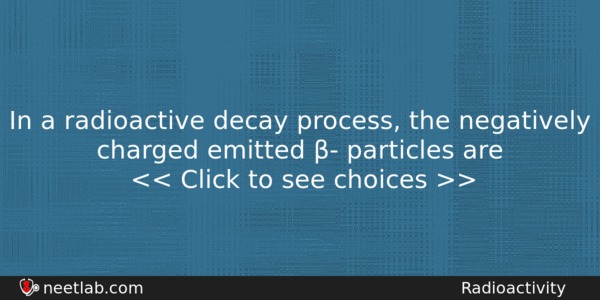| ⇦ | 
| ⇨ |
In a radioactive decay process, the negatively charged emitted β- particles are
Options
(a) the electrons produced as a result of the decay of neutrons inside the nucleus
(b) the electrons produced as a result of collisions between atoms
(c) the electrons orbiting around the nucleus
(d) the electrons present inside the nucleus
Correct Answer:
the electrons produced as a result of the decay of neutrons inside the nucleus
Explanation:
In beta minus decay (β⁻), a neutron is transformed into a proton, and an electronis emitted from the nucleus along with antineutrino.
n = p + e⁻ + v⁻
Related Questions: - At which place, Earth’s magnetism becomes horizontal
- α-particles, deuterons and protons of same energy are moving in a perpendicular
- A bullet is shot from a riffle. As a result the rifle recoils.The kinetic energy of riffle
- An LED is constructed from a p-n junction based on a certain semi-conducting
- Which of the following is a vector quantity?
Topics: Radioactivity
(83)
Subject: Physics
(2479)
Important MCQs Based on Medical Entrance Examinations To Improve Your NEET Score
- At which place, Earth’s magnetism becomes horizontal
- α-particles, deuterons and protons of same energy are moving in a perpendicular
- A bullet is shot from a riffle. As a result the rifle recoils.The kinetic energy of riffle
- An LED is constructed from a p-n junction based on a certain semi-conducting
- Which of the following is a vector quantity?
Topics: Radioactivity (83)
Subject: Physics (2479)
Important MCQs Based on Medical Entrance Examinations To Improve Your NEET Score
18000+ students are using NEETLab to improve their score. What about you?
Solve Previous Year MCQs, Mock Tests, Topicwise Practice Tests, Identify Weak Topics, Formula Flash cards and much more is available in NEETLab Android App to improve your NEET score.
Share this page with your friends

Leave a Reply